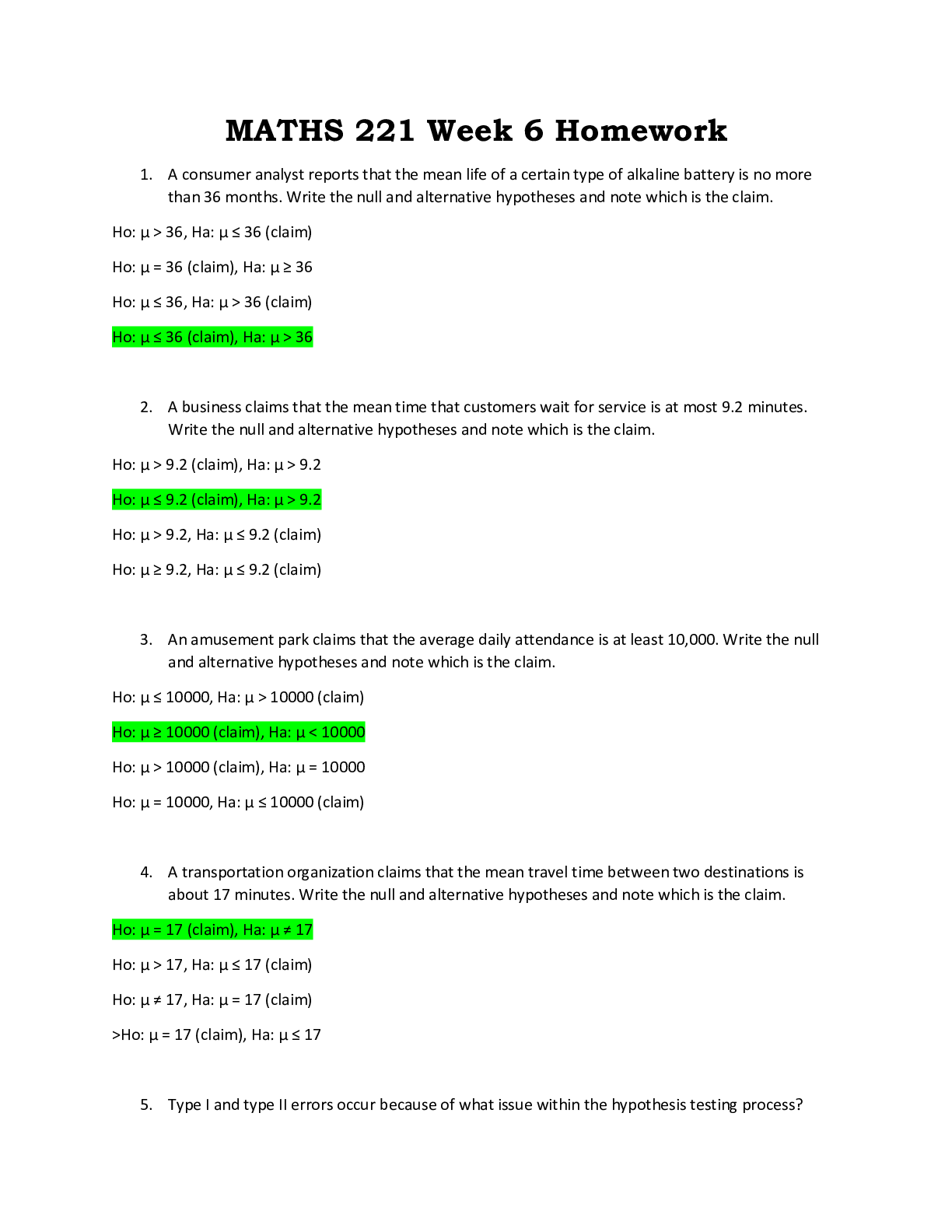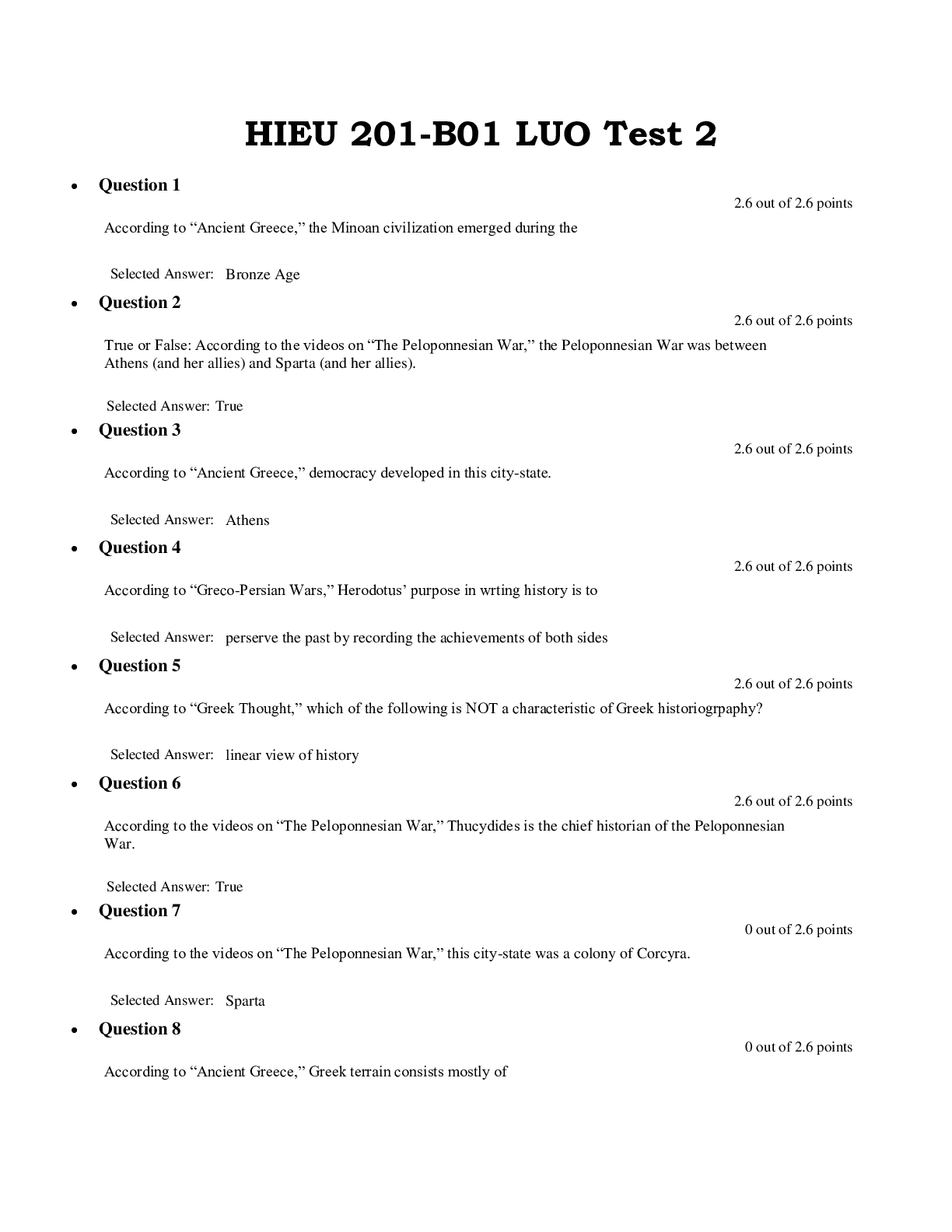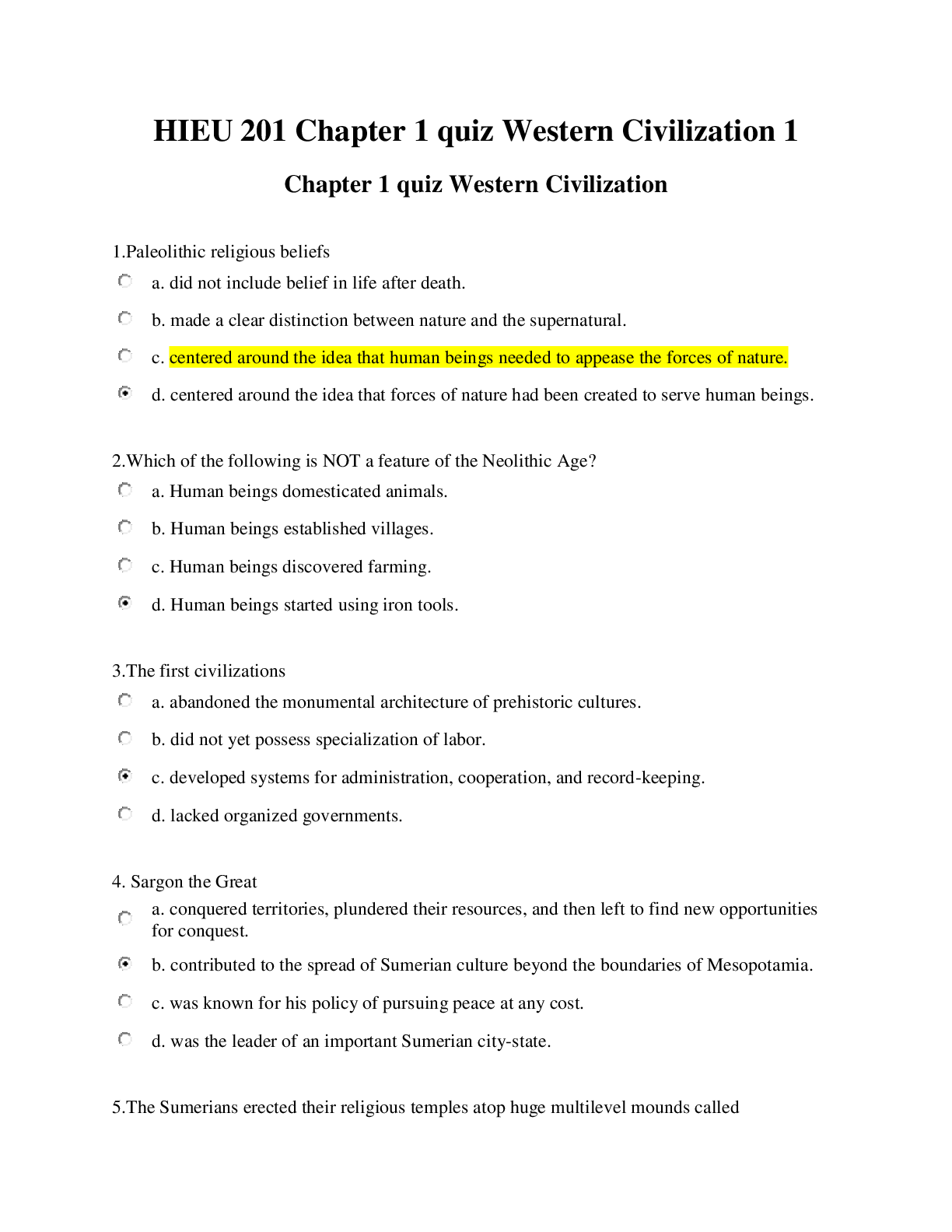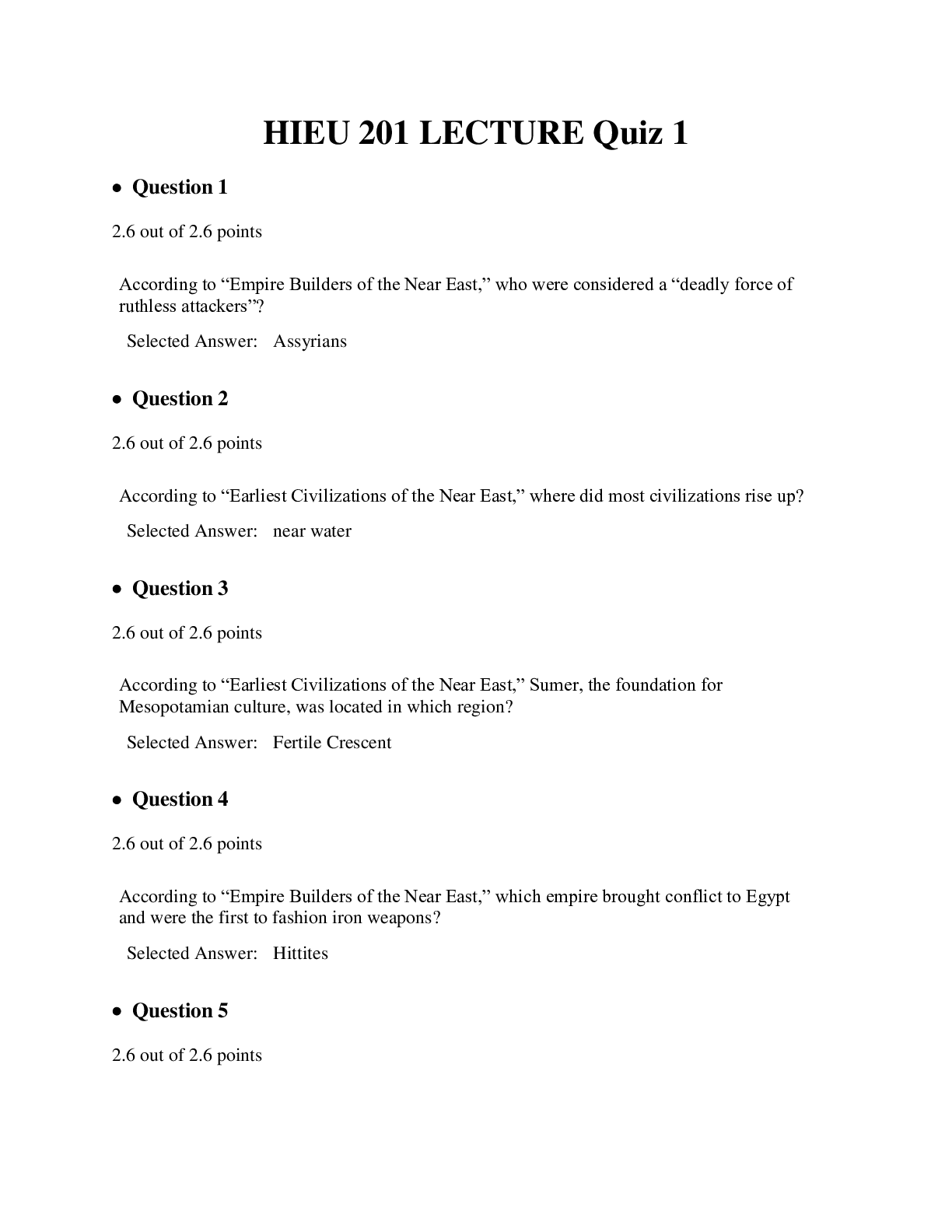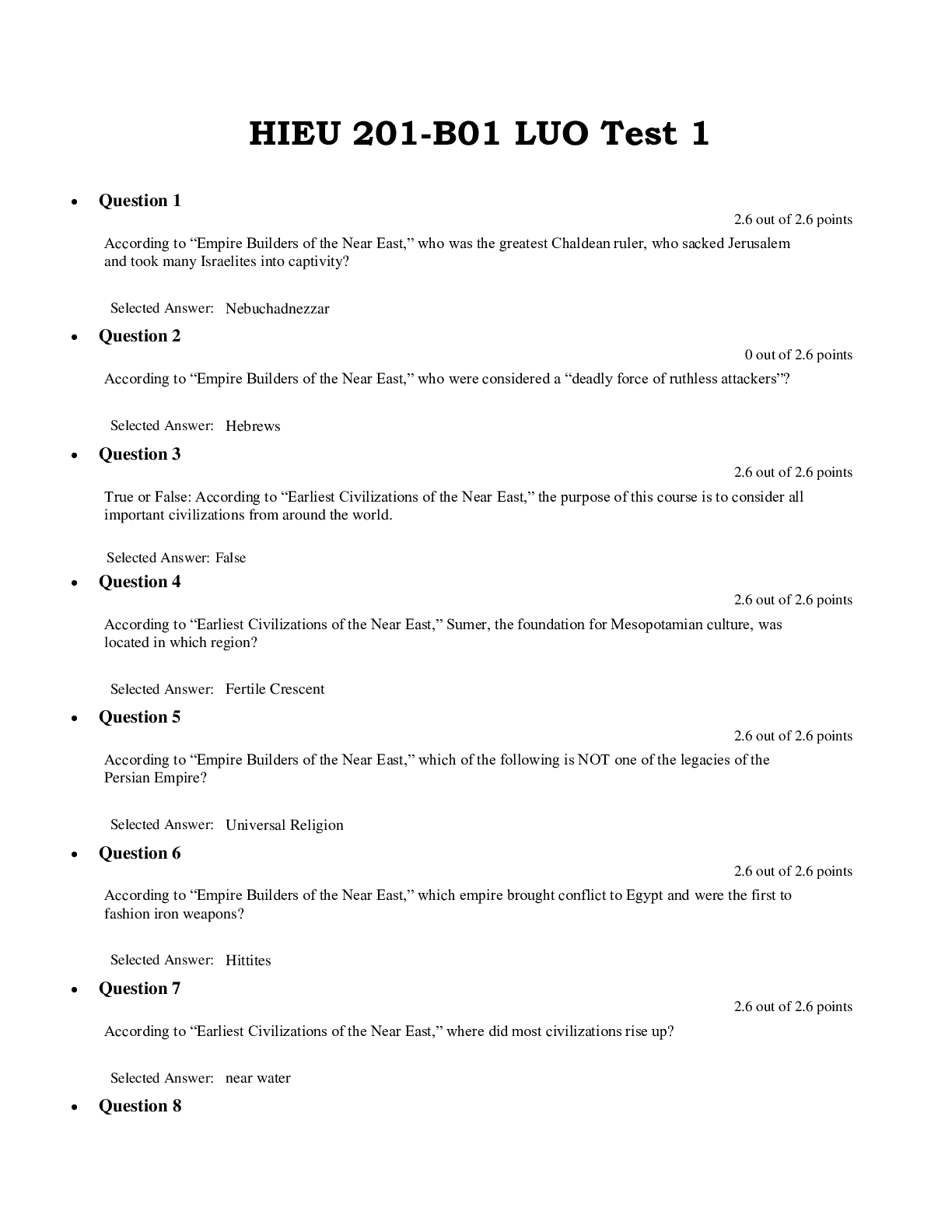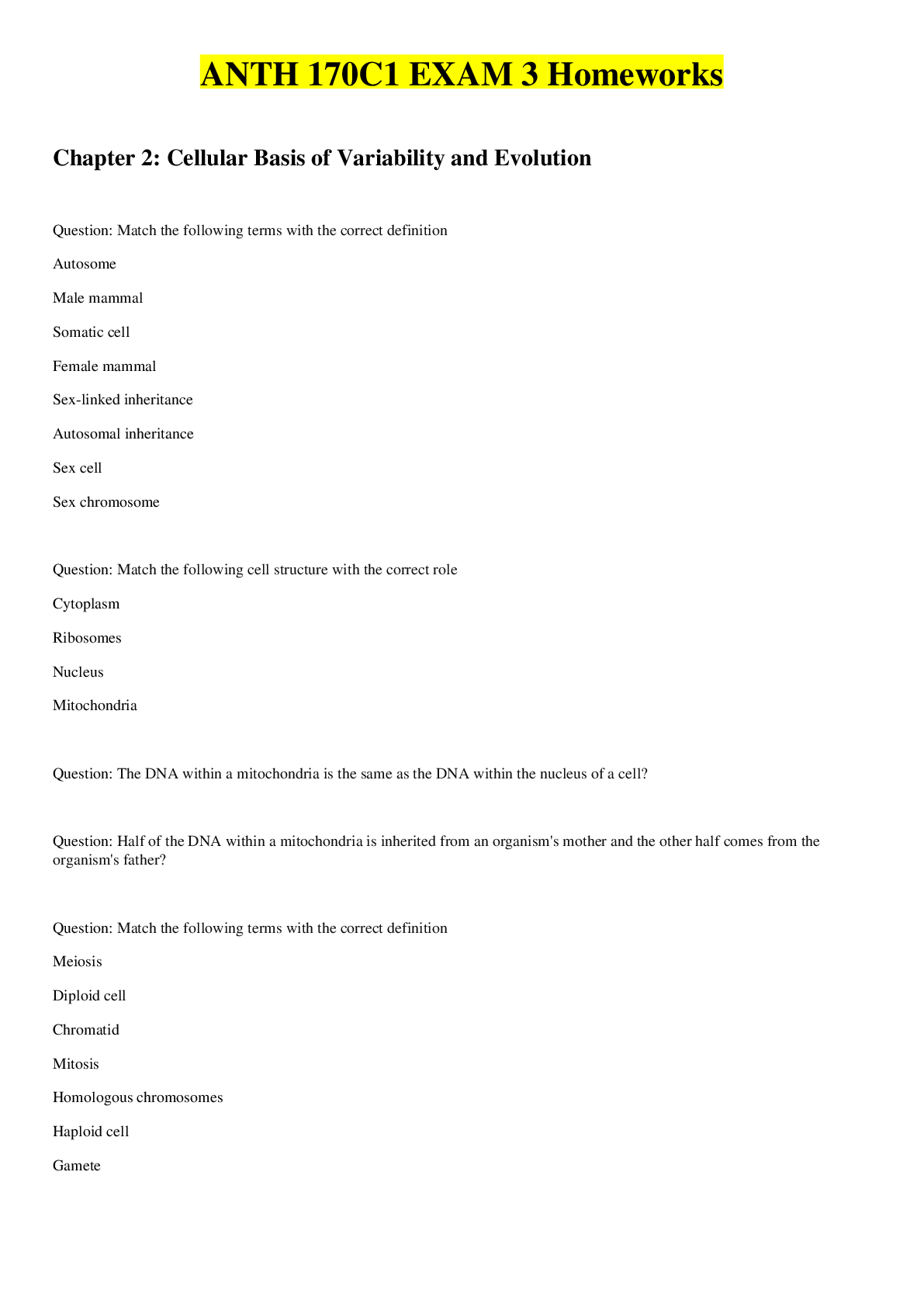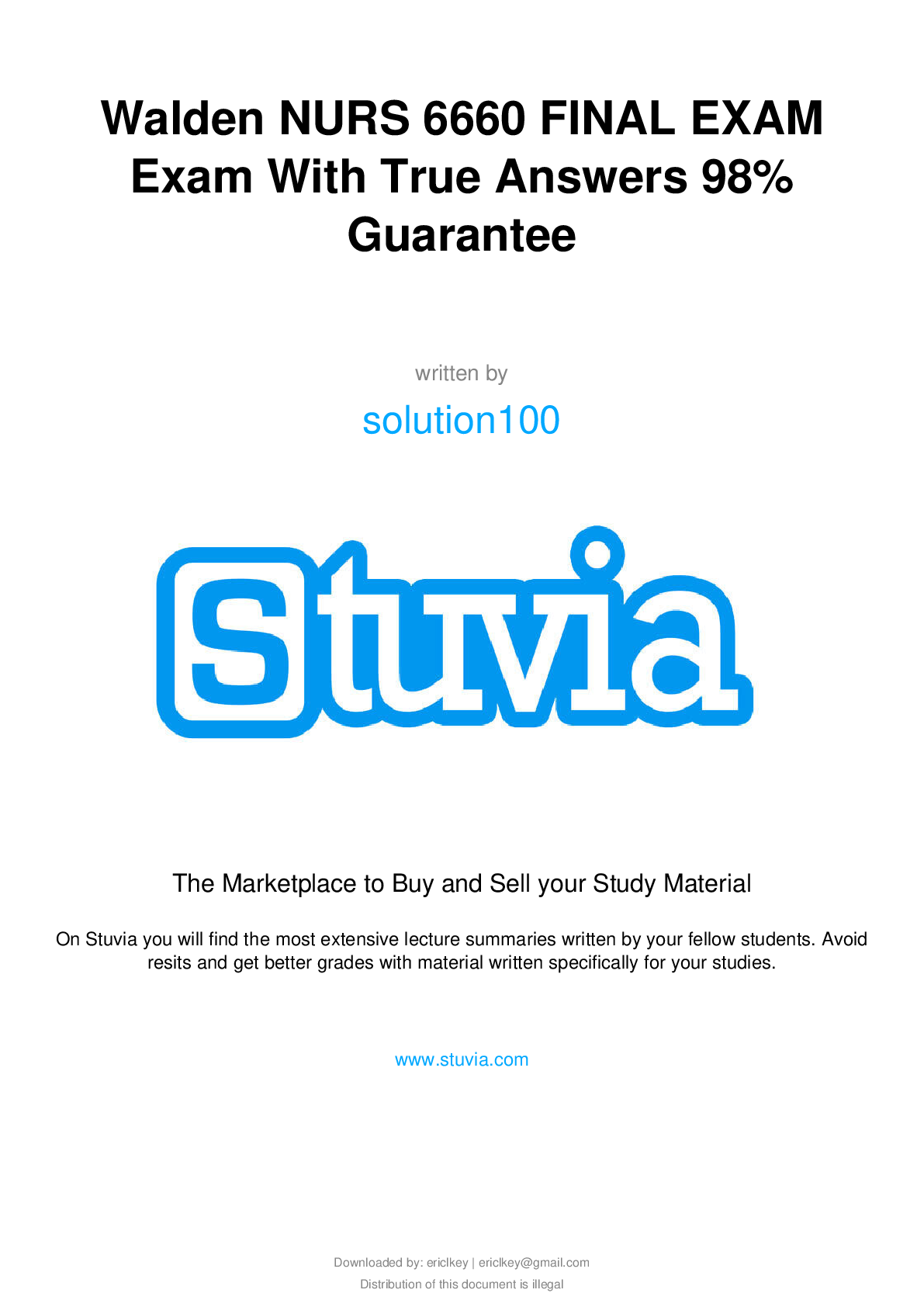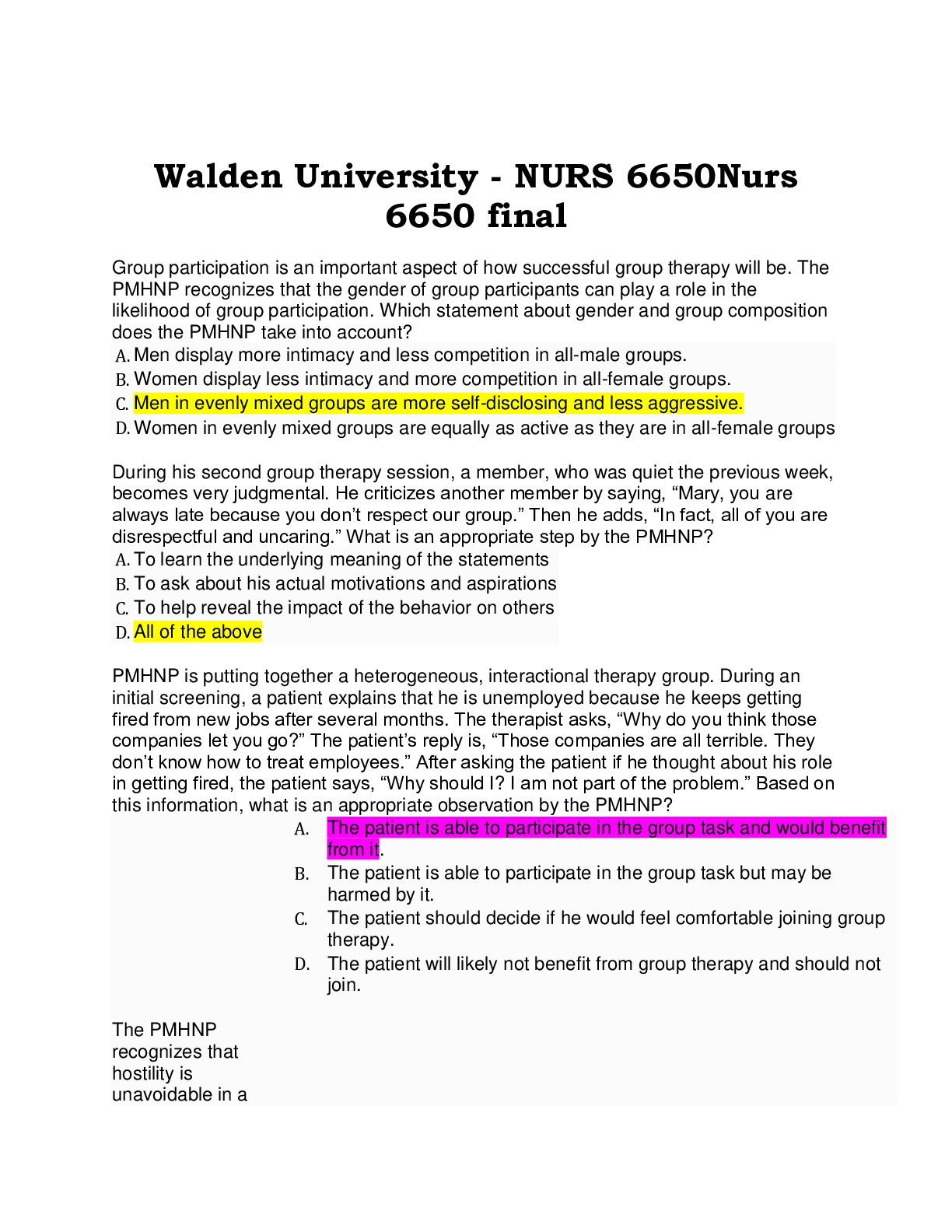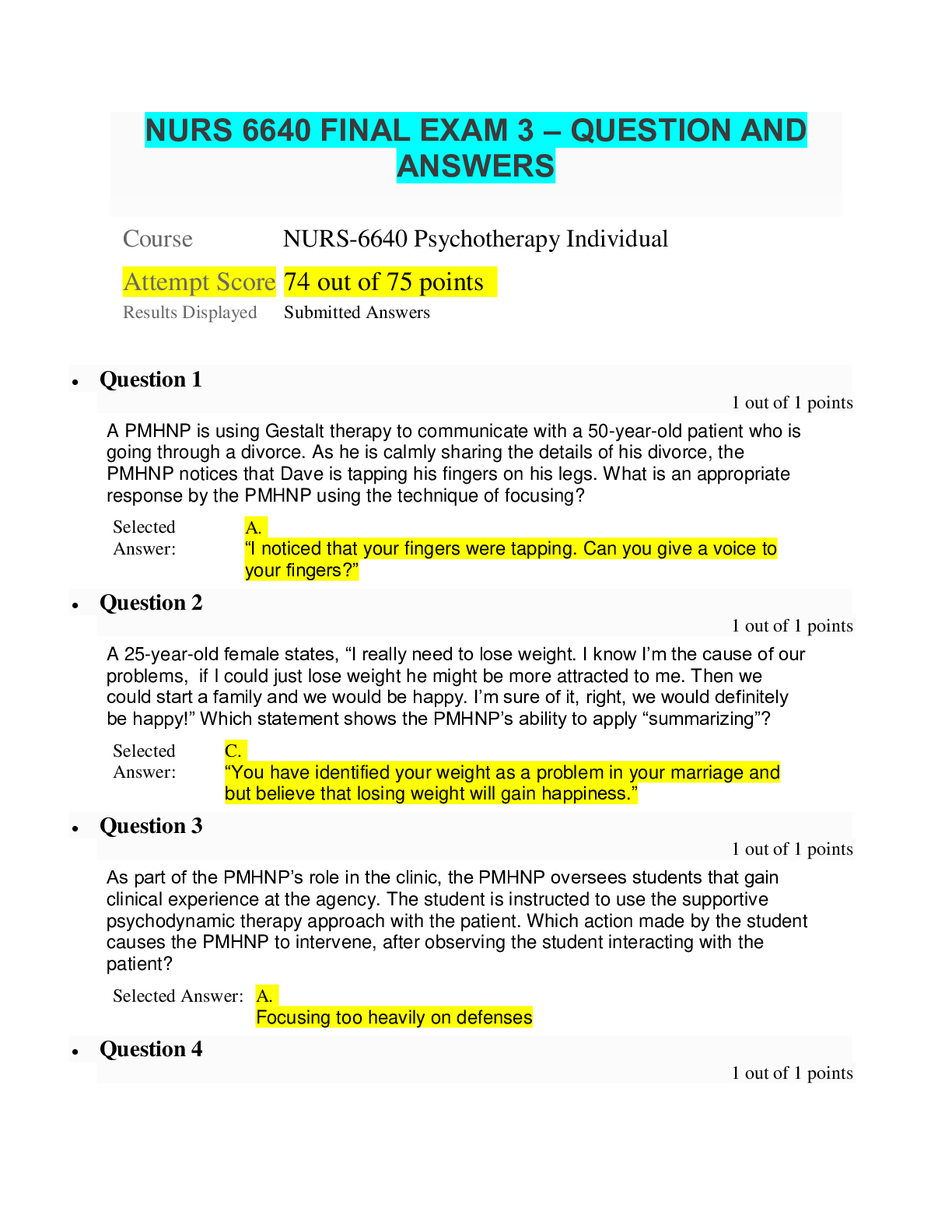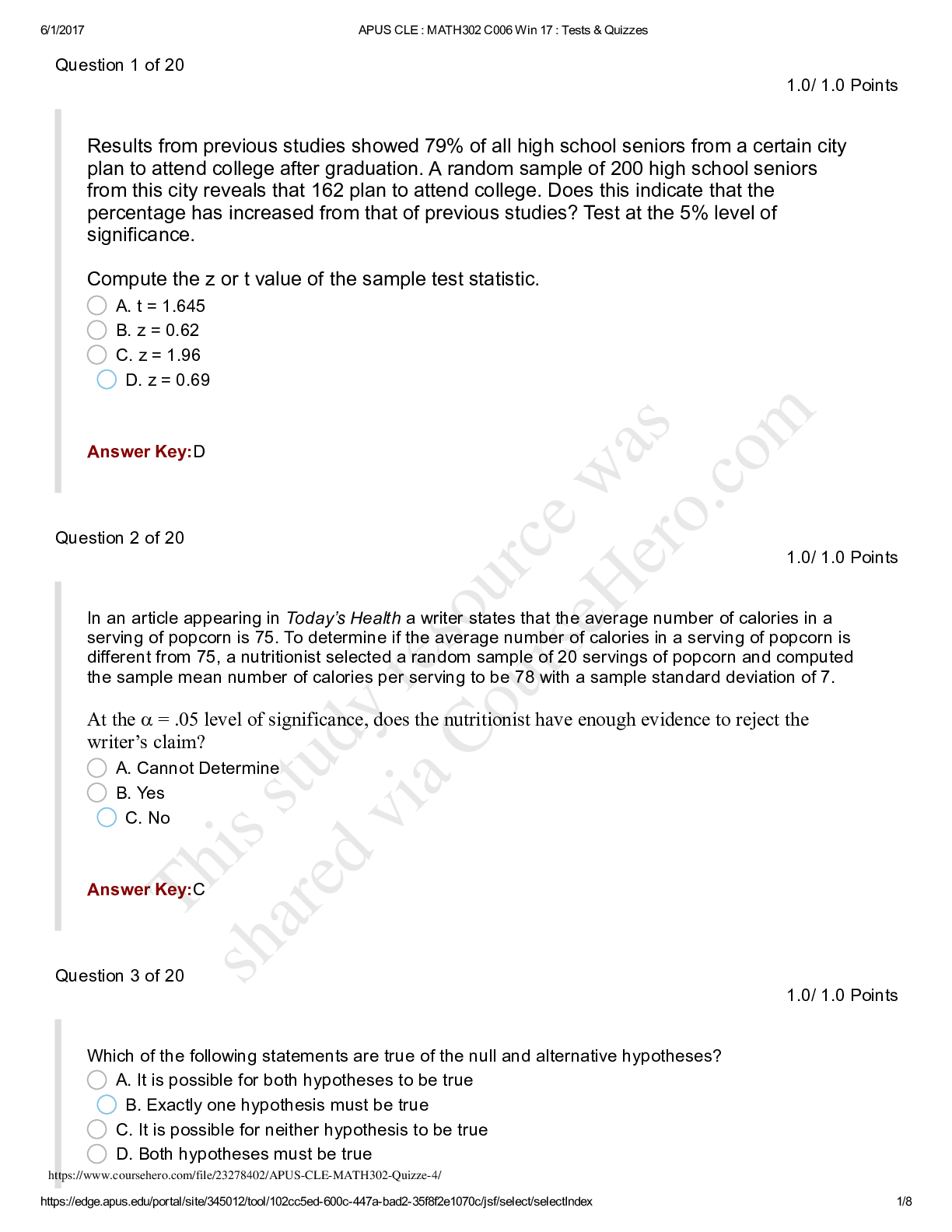*NURSING > QUESTIONS & ANSWERS > NURSING NR602 Chapter 6: Skin and Lymphatic Disorders Multiple Choices (All)
NURSING NR602 Chapter 6: Skin and Lymphatic Disorders Multiple Choices
Document Content and Description Below
NURSING NR602 Chapter 6: Skin and Lymphatic Disorders Multiple Choices Identify the choice that best completes the statement or answers the question. ____ 1. Which of the following dermatological ... conditions results from reactivation of the dormant varicella virus? A. Tinea versicolor B. Seborrheic keratosis C. Verruca D. Herpes zoster ____ 2. An older adult male presents with pain in his right chest wall for the past 48 hours. Upon examination, the nurse practitioner notices a vesicular eruption along the dermatome and identifies this as herpes zoster. The NP informs the gentleman that: A. All symptoms should disappear within three days B. Oral medications can dramatically reduce the duration and intensity of his symptoms C. He has chickenpox and can be contagious to his grandchildren D. He has a sexually transmitted disease ____ 3. A 70-year-old white male comes to the clinic with a slightly raised, scaly, pink, and irregular lesion on his scalp. He is a farmer and works outside all day. You suspect actinic keratosis, but cannot rule out other lesions. What recommendation would you give him? A. Ignore the lesion, as it is associated with aging. B. Instruct him to use a nonprescription hydrocortisone cream to dry up the lesion. C. Perform a biopsy or refer to a dermatologist. D. Advise him to use a dandruff shampoo and return in one month if the lesion has not gone away. ____ 4. The immunofluorescent antibody (IFA) is a laboratory test used to diagnose which of the following disorders? A. Tinea versicolor B. Herpes zoster C. Squamous cell carcinoma D. Human papilloma virus ____ 5. A wound with drainage and foul odor should be cleansed with: A. Normal saline B. Hydrogen peroxide C. 20% acetic acid D. Betadine ____ 6. A full thickness pressure ulcer is partially covered with eschar and the surrounding tissue is reddened. Which of the following is the most appropriate treatment for this condition? A. Apply an occlusive dressingB. Debride mechanically or chemically C. Saline moistened gauze dressings D. Vacuum-assisted wound closure ____ 7. In examining the skin of your nursing home patient, you note a “stained glass” brownish mark on the face. Which of the following lesions best describes a stained glass brownish mark? A. Actinic keratosis B. Seborrhea keratosis C. Lentigo maligna D. Superficial spreading malignant melanoma ____ 8. Patients who have an underlying tinea infection to the cellulitis should also be treated with which one of the following? A. An anti-fungal medication B. Topical steroids C. Oral steroids D. Zinc oxide ____ 9. Identify the type of malignant melanoma that is associated with the Hutchinson’s sign of the cuticle of the finger. A. Lentigo maligna B. Acral lentiginous C. Nodular D. Superficial spreading malignant melanoma ____ 10. A smooth round nodule with a pearly gray border and central induration best describes which skin lesion? A. Seborrheic keratosis B. Malignant melanoma C. Herpes zoster D. Basal cell carcinoma ____ 11. Cellulitis is a deep skin infection involving the dermis and subcutaneous tissues. The nurse practitioner suspects cellulitis in a 70-year-old Asian diabetic male presenting with reddened edematous skin around his nares. Which statement below will the nurse practitioner use in her decision-making process for the differential diagnosis pertaining to reddened edematous skin? A. Cellulitis is two times more common in women B. Facial cellulitis is more common in people >55 C. There is low incidence of cellulitis in patients with diabetes D. Cellulitis is only a disease of the lower extremities of patients with known arterial insufficiency ____ 12. An 82-year-old female has a “pimple” on his nose that occasionally bleeds and may have increased in size in the past year. The lesion is a 0.7-cm, dome-shaped, umbilicated papule with pearly translucence. There is also a hemorrhagic crust covering the central portion. Which of the following is the most likely diagnosis? A. Squamous cell carcinoma B. Basal cell carcinomaC. Keratocanthoma D. Sebaceous hyperplasia ____ 13. Which of the following is generally not a first-line treatment for post herpetic neuralgia? A. Intrathecal methylprednisolone B. Gabapentin C. 5% lidocaine patch D. Topical capsaicin ____ 14. A nursing home resident with a Stage 4 pressure ulcer that extends to the muscle layer and has significant undermining with heavy exudate should be treated with: A. Dry gauze dressings B. Duoderm C. Chemical debridement D. Calcium alginate dressings ____ 15. Which of the following descriptions accurately documents cellulitis? A. Cool, erythematous, shiny hairless extremity with decreased pulse B. Scattered, erythematous ring-like lesions with clear centers C. Clearly demarcated, raised erythematous area of face D. Diffusely inflamed skin that is warm and tender to palpation ____ 16. Asymmetrical bi-color lesion with irregular border measuring 8 mm is found on the right lower arm of an adult patient. This assessment finding is consistent with: A. Melanoma B. Basal cell carcinoma C. Leukoplakia D. Senile lentigines ____ 17. Which of the following descriptions best illustrates assessment findings consistent with tinea capitis? A. Circular erythematous patches with papular, scaly annular borders and clear centers B. Inflamed scaly dry patches with broken hairs C. Web lesions with erythema and scaling borders D. Scaly pruritic erythematous lesions on inguinal creases ____ 18. A hyperkeratatotic nodule formed as the result of exposure of the foot to moisture from perspiration is called: A. Hard corn B. Tinea pedis C. Soft corn D. Plantar warts (verrucae) ____ 19. A 64-year-old male presents with an exacerbation of psoriasis. His social history includes 50-year two packs a day of cigarettes and a six-pack a week of beer. He states he had a recent sore throat, which he attributes to minding his young grandson. He reports that until recently the pruritis was only minimal. His BMI is 37. Which of the following factors most likely contributed to the acute presentation of psoriasis? A. Alcohol abuseB. Smoking C. Streptococcal infection D. Obesity ____ 20. Treatment of complicated cellulitis of the lower extremity resulting from an anaerobe requires all of the following except: A. Extended antibiotic medication lasting at least 7-10 days B. Topical antifungal medication C. Inquiry when last tetanus toxoid booster was given D. Elevation of limb and consideration of compression bandagingChapter 6: Skin and Lymphatic Disorders [Show More]
Last updated: 1 year ago
Preview 1 out of 5 pages
Instant download
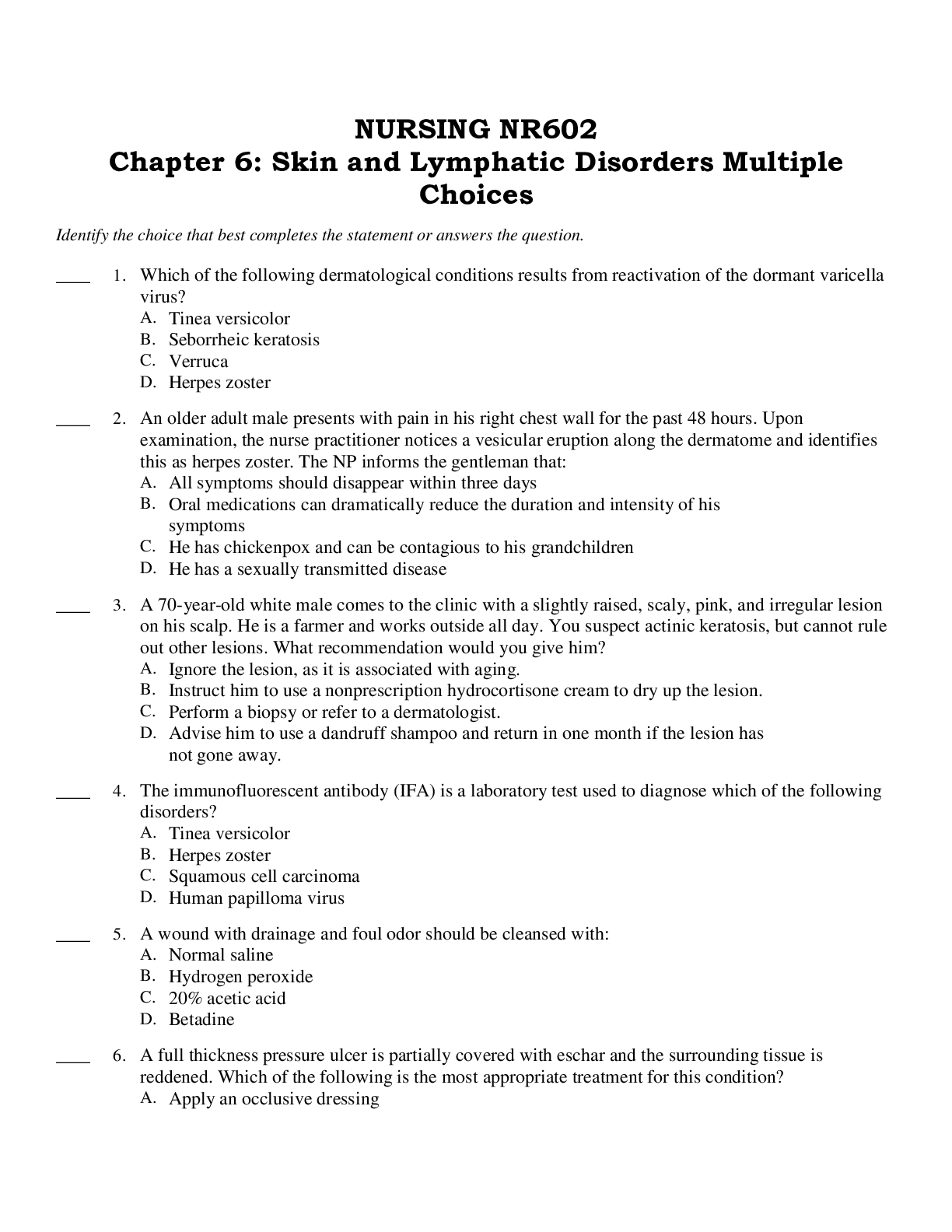
Buy this document to get the full access instantly
Instant Download Access after purchase
Add to cartInstant download
Reviews( 0 )
Document information
Connected school, study & course
About the document
Uploaded On
Mar 18, 2021
Number of pages
5
Written in
Additional information
This document has been written for:
Uploaded
Mar 18, 2021
Downloads
0
Views
74

